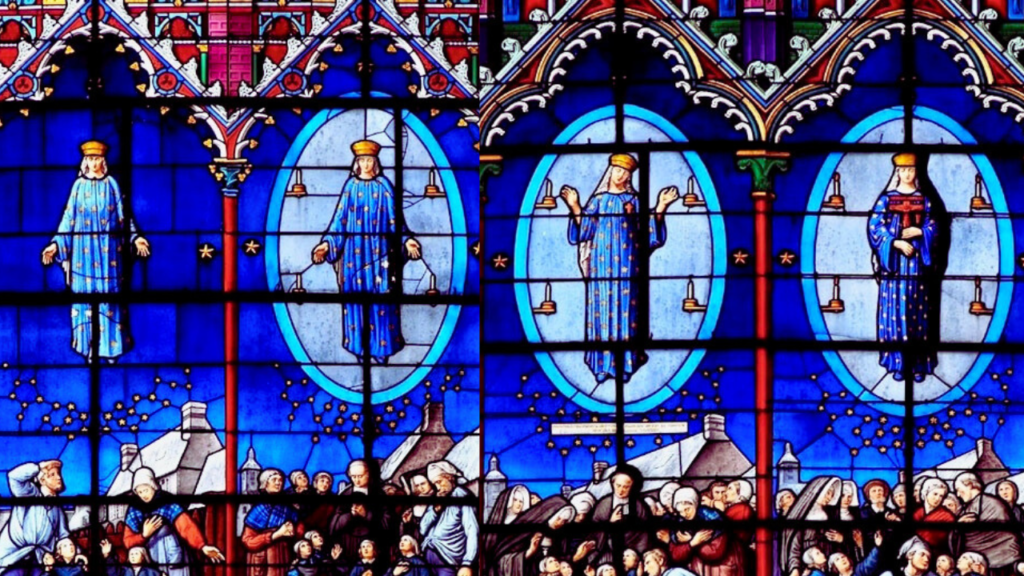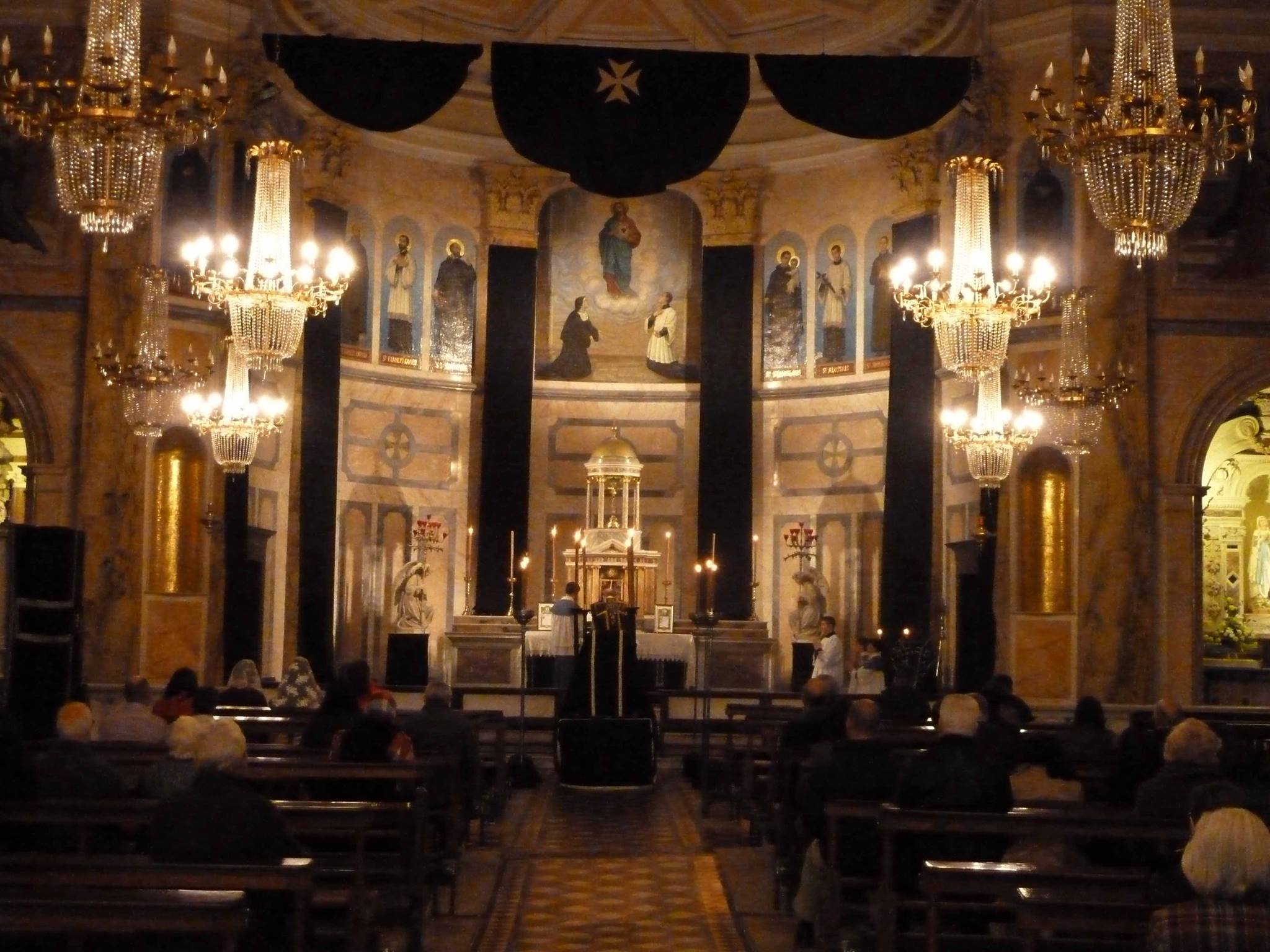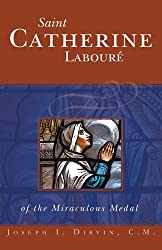
CJS.Org Introductory Remarks:
This is the first part of a highly detailed, well-researched narrative of the Apparition of Our Lady of Pontmain. This is taken from Bernard St John’s 1904 book The Blessed Virgin in the Nineteenth Century: Apparitions, Revelations, Graces.
There are three parts to this series:
- Part 1 The Blessed Virgin Appears in the Night Sky
- Part 2 – The Blessed Virgin Brings a Message to Catholic France
- Part 3 – A Crucifix the Colour of Arterial Blood
Before turning to Bernard St. John, let us note that this is the last and least known of the four great approved Marian Apparitions which occurred in Nineteenth Century France. It occurred in early 1871, after the Blessed Virgin had appeared on French soil in 1830 (the Rue du Bac, Paris) 1846 (La Salette) and most famously Lourdes in 1858.
In order to fully appreciate the significance of Our Lady’s 1871 appearance at Pontmain, it is necessary to know a little of the French history of that time.
Briefly, as 1871 began, France had just suffered a massive invasion from Prussia.
Like the German armies later did in WWI and WWII, Prussian armies had swept across the north of France, laying siege to Paris and moving eastwards into Brittany … and towards Pontmain.
France was incalculably traumatised and as Bernard St John makes clear, sending up prayers of penitence and supplication.
For at that time, the common opinion of Catholics was that France had suffered this terrible and unprecedented defeat, because she had been unfaithful.
For this was an era when France was still not the ultra-secular country she has become day. A vast number of French – perhaps half the population – still deplored the 1789 revolution that had killed the king and vast numbers of Catholics.
Through bearing these considerations in mind, we hope that many readers can better understand the series on Our Lady of Pontmain which commences here …
Pontmain! Pontmain! We cannot easily refrain in our gratitude to Our Lady of Pontmain.
For Kim and I, who created this website, received real grace in Pontmain in France. And for any who may be interested, there is a very personal weblog entry here about our precious, precious time there.
But after that digression, we turn now to Bernard St John and the first part of our series – RB.
Bernard St. John on the Pontmain Apparition
We are in January, 1871. Paris was besieged; two-thirds of the country were in the enemy’s power; the battle of Le Mans had laid Mayenne and Brittany open to the invaders.
Brittany as yet remained intact; but the irruption of the invaders into the neighbouring Mayenne made the movement westward appear imminent.
Then would France have been swept by German soldiery from the Rhine to her extremest ocean frontier.
This is the historic background against which the Apparition of Pontmain must be seen. But there is another background to our subject: it is that of prayer rising from different parts of France as from one heart and from one voice.
The voice of supplication grew more intense and more piteous at and towards that spot where the invader’s next attack was expected. This spot was Laval, chief town of the Mayenne.
There priests and people had besieged Heaven with their prayers, praying especially at the shrine of Notre-Dame d Avenieres. Rennes was not behindhand in the movement; nor Saint-Brieux, which was a very stronghold of prayer in the present emergency.
There, on the memorable January 17th with which we have to do, supplications under exceptional circumstances rose for France, and a solemn promise was made. The hour was between five and six in the evening. The spot where this patriotic and religious manifestation took place was the well-known chapel of Notre-Dame d’Esperance (Our Lady of Hope), the seat of the Archconfraternity founded under that name.
With the background of prayer thus faintly limned before us, we will glance on this same evening of January 17th, 1871, from Saint-Brieux in Brittany to Pontmain in the Mayenne forty leagues off.
Pontmain, a hamlet of some five hundred inhabitants, was to become for ever memorable because of the page of its history to be written that night. Even its geographical position on the borderland between Brittany and Mayenne was to assume historical importance.
Seen by the light of the celestial drama about to be enacted above it, it was to appear as a sentinel guarding Brittany and driving back the invader.
Foreword for Monarchy by Roger Buck
Belonging to the diocese of Laval, Pontmain was sharing in the fear and desolation reigning through out that city, which the Germans were hourly expected to beseige.
On that night, when it was about to pass into history, we see it beneath a star lit sky and with the whitened roofs of its houses and homesteads showing- against a carpet of frost and snow. The air was intensely cold. The hour was between five and six.

From this scene, already becoming wrapped in night gloom, we will single out a barn in which, beneath the eye of their father, Cesar Barbedette, two boys were busy breaking up gorse as food for cattle. The lads, Eugene and Joseph, were aged respectively ten and twelve.
They were interrupted in their work by the entrance of a woman of the locality, Jeannette Detais by name. This person had that day heard tidings calculated to console the Barbedette family, and it was to convey these tidings that she looked into the barn that evening.
The news was concerning a young soldier, Auguste Friteau, who was the son of Cesar Barbedette’s wife by a former marriage, and, consequently, half-brother to the boys, Eugene and Joseph.
The father and the younger boy, seated on the furze which they had been breaking up, listened to what Jeannette had to say. Not so the elder boy, who, almost at once, went to the open door and stood there looking up at the sky.
This conduct was the more noticeable on his part for the reason that he was particularly fond of the absent Auguste Friteau, who was moreover his godfather.
Joseph Barbedette, later on, alluding to this circumstance, says: “Humanly speaking, I have never been able to understand why Eugene left us just as we were hearing news of his godfather, of whom he was so fond.”
Eugene’s reason, as given afterwards, was that he went to see what the weather was like. During the quarter-of-an-hour that followed he remained standing by the open door looking up at the sky.
At first he looked at the stars, which appeared to him unusually bright and numerous. Suddenly his sight became rivetted.
Above the house in front of him, and a little behind it, high in the air, though near enough to be distinctly seen, he saw what he took to be a beauteous human figure.
The words that after wards framed themselves in his mind to express what he then saw were: “Une grande belle dame.” He was not frightened. On the contrary, he felt happy, and, though moved to the soul, continued to gaze.
The conversation within had come to an end, and Jeanette Detais was about to leave. As the woman stood by the door Eugene said to her: “Jeannette, look above Augustin Guidecoq’s house and tell me if you see anything.”
Jeannette looked. “I see nothing at all, Eugene,” was the reply.
Cesar Barbedette and his younger son, hearing these words, came to the door and looked out. The father was the first to look up. All he could see was a blue starlit sky. Then Eugene said to his brother: “Can you see anything, Joseph?

“Oh, yes!” exclaimed the latter, “I see a tall, beautiful lady!” (Une grande belle dame.)
“How is she dressed?” asked Eugene.
“She has a blue dress and blue chaussons,” said the other.
“Has she a crown on her head?” was next asked.
“Yes,” was the reply; “a gold crown getting wider towards the top, and with a red line round the middle; and she wears a black veil.”
The younger boy’s description exactly corresponded with what the elder one had seen and continued to see.
The father listened to the boys, looking up at the sky all the time.
After a few seconds, he said: “My poor little boys, you see nothing at all. If there were anything to be seen, I should see it as well as you. Go in and finish breaking up the gorse. Supper will soon be ready.”
Then, turning to Jeannette Detais, he added: “Say nothing about this to anyone, as it might cause talk. The children are mistaken.”
“You need have no fear that I shall say anything,” replied the woman, and she went her way.

The boys went back to their work in the barn. Needless to say their thoughts were not with what they were doing, but with what they had seen.
The father’s thoughts appeared to be in the same direction, for after a few moments he stopped short and said: “Eugene, go and see if the same thing is to be seen.”
The boy was at the barn door in a second. “Oh yes, father!” he exclaimed joyfully; “it is just the same as before.”
“In that case,” said the father, “go and fetch your mother. If there is anything to be seen, she will see it; but say nothing to Louise” (Louise was the servant).
“You have only,” continued Cesar Barbedette, “to tell your mother that I want to speak to her.”
The elder boy ran off, the younger one the while taking advantage of the break in the work to slip outside the door. There he continued looking up at the figure in the firmament that had so rivetted his gaze a few minutes before.
Before going further it will be well to give a description of this figure in the night sky. Presently, on that spot, every detail concerning it was to be told again and again to a little crowd assembled.
And later on, able pens and enlightened minds were to scatter to the four quarters of the globe the facts put forth that evening.
But for our purpose of conveying to the reader in human words something of the sublime picture which the children saw, we prefer quoting from Recit d’un Voyant of the Rev. Joseph Barbedette, now a priest and member of the Congregation of the Oblates of Mary Immaculate.
What Joseph Barbedette said on this subject as a child he has written as a man; and, to use the words of the Rev. Jean-Baptiste Lemins, O.M.I., his testimony “is a priestly one an oath, so to speak, renewed each day on the altar and over the chalice, and signed with the blood of Christ.”
His description is as follows: “In the air, seven or eight metres above Augustin Guidecoq’s house, I saw a woman of extraordinary beauty. She appeared to be young about eighteen or twenty years of age and tall of stature.
She was clad in a garment of deep blue. When we were told to describe exactly the shade of this blue, we could only do so by comparing it to balls of indigo such as laundresses use for rinsing linen.
Her dress was covered with gold stars, pentagonal in form, all of the same size, and brilliant, but without emitting rays. They were not very numerous, and seemed to be scattered over the blue without regard to method.
The blue garment was ample, showing certain strongly-marked folds, and without girdle or compression of any kind from the neck to the feet. The sleeves were ample and long, falling over the hands. On the feet, which the dress left uncovered, were chaussons of the same blue as the dress and ornamented with gold bows.
On the head was a black veil half covering the forehead, concealing the hair and ears, and falling over the shoulders.
Above this was a gold crown resembling a diadem, higher in front than elsewhere, and widening out at the sides. A red line, from five to six millimetres wide, encircled the crown at about the middle.
The hands were small, and extended towards us as in the miraculous medal, but without emitting rays. The face was slightly oval.
To the freshness of youth was added the most exquisite delicacy of feature and of tint, the complexion being pale rather than otherwise. Smiles of ineffable sweetness played about the mouth.
The eyes, of unutterable tenderness, were fixed on us. I give up further attempting to describe the beautiful figure of her who looked down upon us and smiled.
Like a true mother, she seemed happier in looking at us than we in contemplating her.”
The writer continues: “Notwithstanding that it was night, and that we were separated from the beautiful Apparition by a distance of about a hundred metres, we could see every detail of the face as distinctly as if it had been in full daylight and we had been close by.”
He who, as a priest and a religious, gives us this description, was, as a lad of ten, still looking up into the night sky, when his mother, Victoire Barbedette, arrived on the scene on the memorable January evening in question.
More than this, the little boy was not only looking up into the heavens, but clapping his hands with delight, and exclaiming: “Oh, how beautiful! how beautiful!”
The father meanwhile was looking on in silence. The mother, in presence of this ebullition on the part of her youngest son, went up to the little lad, and giving him a smart slap on the arm, said: “Will you be quiet? Do you not see that the neighbours are looking at us?”
“I cared little what the neighbours were doing,” said Joseph afterwards, “but this smart admonition from my mother made me understand that my raptures were out of place.”
“Mother,” said Eugene, the elder boy, “look up yonder above the house. Do you not see some thing?” The mother looked in the direction pointed to, and then said that she saw nothing.
On this, both boys said together: “Do you not see a tall, beautiful lady with a blue dress, and a black veil and a crown on her head ?”

“I see nothing at all,” was the reply.
The father continued to look and to listen in silence, but moved to the extent that his eyes were full of tears.
His wife, noticing this, and knowing, moreover, that her boys were not in the habit of lying, began to ask questions.
After listening to what the two had to say, her first impression was that it was an Apparition of the Blessed Virgin they had seen.
Bv this time the sound of voices and the exclamations of the younger boy had attracted the attention of neighbours, and people were seen looking out at their doors.
“What is the matter?” asked one from a little distance.
“Nothing,” said Victoire Barbedette; “the children say they see something, but we see nothing at all.”
On this, carrying out a previous idea, she gathered her family round her in the barn and shut the door. There, the little party fell on their knees, and with faces turned in the direction of the Apparition, they recited five times the Lord’s Prayer and five times the Hail Mary.
This done, the boys, with their mother’s leave, again opened the barn door.
“Do you still see the same thing?” asked Victoire.
“Oh yes, just the same, mother,” was the reply. “I shall go and fetch my spectacles,” said the good woman, “and then I shall see as well as you.”
She quickly came back, followed by Louise the servant. “Now,” said she, adjusting her spectacles, “I too shall be able to see. In what direction is it?”
“Yonder, mother, yonder,” said the two boys pointing with their finger.
“Mother Victoire,” as she was familiarly called in the burgh, began looking as intently as she was able. Louise, the servant, did the same, but neither she nor her mistress could see anything but the stars.
At this juncture, according to the testimony of the two boys, the smile on the face of the Apparition became more marked than heretofore.
Balked in her attempt to see what her sons saw, the mother’s action assumed a shade of asperity.
Turning to the lads, she said: “The truth is, you see nothing – at all, and you are two little story tellers. Go in at once and finish your work. Supper will be ready.”
“Though not in the habit of humouring us, our mother had never spoken to us so harshly before,” said Joseph Barbedette, alluding long afterwards to this incident.
Compelled to return to their work in the barn, the two boys had quickly finished. They then went home, walking backwards all the way, in order not to lose sight for a moment of the beauteous figure in the sky.
“I would stay there all the time if I could,” said Eugene to his father. Almost the first words of the youngest boy on entering his home were: “Mother, may we go back to the barn when we have finished supper? “
The mother consented. “Let us make haste then,” said Eugene.
“Do not let us even sit down,” said the other.
The two having quickly despatched their food, were about to set forth again when their mother said to them: “Since you arc going back there, if you still see the same thing, say again five times the Our Father and the Hail Mary; but do not kneel down because of the cold. Then come back.”
The boys, on reaching the spot, in their joy at seeing the Apparition as before, forgot their mother’s injunction not to kneel down. They instinctively fell on their knees at once and began saying five times the Pater and the Ave.
The father, watching them from his house door, said: “They must see the same thing, for they are on their knees saying, no doubt, the prayers you told them to say.”
The prayers ended, they returned home as they had been told to do.
The mother, more interested than she wished to appear, began asking questions as to the size of the figure in the sky.
“She is about the size of Sister Vitaline,” was the reply. Sister Vitaline was the nun who taught the boys at school.
An idea flashed through Victoire Barbedette’s mind which she lost no time in carrying into effect.
Accompanied by her son Eugene, she at once set forth in quest of Sister Vitaline, saying to herself that nuns were better than other people, and that if there was anything in the sky to be seen, this nun would see it.
She found the good sister in the schoolroom saying her office, and asked her to accompany her at once to the barn. “The children see something in the sky,” she said. “I have not been able to see anything, nor has Louise, but that is, I suppose, because our eyes are not good enough.”
“My eyes are excellent,”said Sister Vitaline, “and if there is anything to be seen, I do not doubt but that I shall be able to see it.”
The little party of three set off. When they had reached the barn door, Eugene, pointing to the spot where the Apparition was, said: “Now, do you see it, Sister Vitaline?”
“It is of no use for me to open my eyes wide,” was the nun’s reply after a moment or two, “for I can see nothing at all.”
“Not see it,”exclaimed the boy energetically. “Do you not,”he continued, “see those three stars forming like a triangle?”
“Yes,” she replied, “I see them.”
“Well then,” pursued the other, “the highest of those stars is just above the head of the beautiful lady (belle dame).”
Sister Vitaline looked again, but could not see more than at first. Under the circumstances she decided on returning home at once.
Victoire Barbedette accompanied her back to the community house, which at the time sheltered but three nuns in all, and when about to leave, exacted from her a promise to say nothing to anyone of the subject which had just brought them together.
The nun gave the promise, and quickly broke it, for on entering and seeing three little pupils warming themselves by the fire, she said to them: “Little girls, go with Victoire; she has something to show you.”
“What is it?” they asked.
“I cannot tell you,” said Victoire, “as I have not seen it myself; but the boys say there is some thing to be seen.”
The little girls were Françoise Richer, Jeanne- Marie Lebosse, and Augustine Mouton. They set forth with Victoire at their head, and having no idea of the nature of the unusual sight there was to be seen.
On drawing near the spot for which they were making, Françoise Richer, looking up, exclaimed: “I see something above the house of Augustin Guidecoq, but I cannot tell what it is.”
In truth, she was getting a side and confused view of what was about to break on her sight in its full beauty and splendour.
Eugene Barbedette was calling to them from before the barn door. As soon as they had joined him, and before they had heard a word of what he had to say, Françoise and Jeanne-Marie cried out together: “Oh, the beautiful lady in a blue dress with gold stars!”
They then gave a detailed description of the Apparition, which exactly corresponded with that previously given by the two boys.
It may be mentioned here that the third little girl, Augustine Mouton, on looking up, saw nothing but the blue, starlit sky.
By this time Joseph Barbedette and his father were on the scene, as well as a few neighbours drawn thither by curiosity. Then Sister Vitaline and her companion nun, Sister Marie-Edouard, made their appearance. Sister Vitaline quickly asked whether the same thing was still to be seen.
“Oh, yes,” cried the four children together; “we see a tall, beautiful lady in a blue dress covered with stars.”
Sister Marie-Edouard tried to see, as Sister Vitaline had done, but with no better success. “Since it is only the children that see,” said she, “we must go and fetch other children and younger ones.”
She at once started off in quest of others, and intending to bring back with her, if she could, the venerable parish priest of Pontmain, Abbé Guerin.
Meanwhile, the little group of people by the barn door increased. While the three great stars forming a triangle could be distinctly seen by all, the sublime picture in part enframed within remained invisible except to the four voyants.
A note of prayer was struck by Sister Vitaline, who began reciting aloud, in union with the by standers, the Rosary of the Japanese Martyrs, while the little crowd around continued to increase.
As Sister Marie-Edouard came back accompanied by Abbé Guerin and others, she called out, while still at a little distance: “Do you see it still?”
“Oh, yes,” was the reply.
One of the new-comers was a woman, carrying in her arms, well-wrapped up, a delicate boy of between six and seven. It was her grandson, Auguste Friteau. The child, on arriving on the scene, uttered a cry of delight.
He, too, on looking up, had seen the Apparition, and was able to describe it as the others had done.
And all he then said concerning it he solemnly reiterated three months later when dying, and just before making his First Communion, which, in spite of his but seven years, he was allowed to do on his death-bed.
There was a sixth child on the scene, the two- year-old daughter of a shoemaker of Pontmain, Boitin by name, who, in her mother’s arms, gave every sign of seeing the celestial picture in the night sky.
All the good Abbé Guerin could see was the starlit heavens, the snow-clad earth, and his little flock around him. In his humility and emotion he remained silent.
Next: Pontmain and Our Lady of Hope Part II – The Blessed Virgin Brings a Message to Catholic France
To Navigate Through This Series:
- Part 1 The Blessed Virgin Appears in the Night Sky
- Part 2 – The Blessed Virgin Brings a Message to Catholic France
- Part 3 – A Crucifix the Colour of Arterial Blood
Foreword for Monarchy by Roger Buck
Buying Books at Amazon Through These Links Gives Us a Commission. This Supports Our Apostolate. Thank You if You Can Help Us Like This!









Comments
comments are currently closed
10 responses to “Pontmain and Our Lady of Hope Pt. 1—The Apparition of the Blessed Virgin”
[…] In the meantime, in addition to this series on Lourdes, the interested reader can also find extracts from Bernard St John on Our Lady of the Miraculous Medal, as well as La Salette (in a series starting here) and Our Lady of Pontmain (in a series starting here) […]
[…] In the meantime, in addition to this series on Lourdes, the interested reader can also find extracts from Bernard St John on Our Lady of the Miraculous Medal, as well as La Salette (in a series starting here) and Our Lady of Pontmain (in a series starting here). […]
[…] holy mountain of La Salette in 1846, to the child Bernadette at Lourdes (1858), to the children of Pontmain (1871) – and perhaps to Estelle Faguette at Pellevoisin in […]
[…] In the meantime, in addition to this series on Lourdes, the interested reader can also find extracts from Bernard St John on Our Lady of the Miraculous Medal, as well as La Salette (in a series starting here) and Our Lady of Pontmain (in a series starting here). […]
[…] « Pontmain and Our Lady of Hope Part I – The Apparition of the Virgin Pontmain and Our Lady of Hope Part III – A Crucifix the Colour of Arterial Blood … » […]
[…] Part 1 The Apparition of the Virgin […]
[…] worn around the neck. And then she appeared again in La Salette and Lourdes urging penance. And in Pontmain with the expression of extreme sadness […]
[…] Apparitions we have covered extensively at this site – at Lourdes, as well as La Salette, Pontmain and of course in Paris at the Rue du […]
[…] In the meantime, in addition to this series on Lourdes, the interested reader can also find extracts from Bernard St John on Our Lady of the Miraculous Medal, as well as La Salette (in a series starting here) and Our Lady of Pontmain (in a series starting here). […]
[…] In the meantime, in addition to this series on Lourdes, the interested reader can also find extracts from Bernard St John on Our Lady of the Miraculous Medal, as well as La Salette (in a series starting here) and Our Lady of Pontmain (in a series starting here). […]